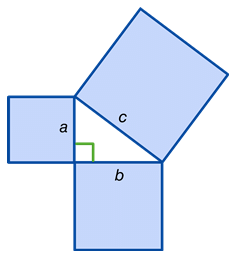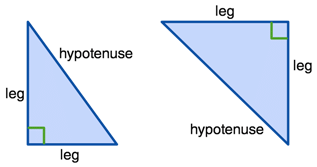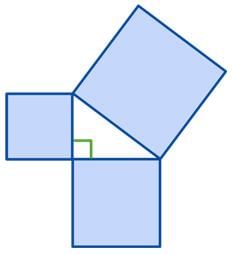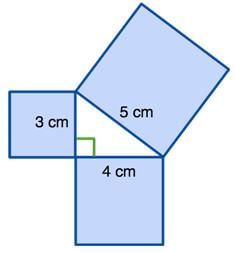Mathematics Exam > Mathematics Notes > Additional Topics for IIT JAM Mathematics > Pythagorean Theorem
Pythagorean Theorem | Additional Topics for IIT JAM Mathematics PDF Download
Pythagorean Theorem: a2+b2 = c2
In a right triangle, the sum of the squares of the two legs equals the square of the hypotenuse.

- Legs (a and b): the sides of the triangle adjacent to the right angle. They don't need to be the same length in order for this theorem to work.
- Hypotenuse (c): the side of the triangle opposite the right angle which, conveniently, is always the longest side.

So, let's break this down. If you square each side of the triangle, the sum of the areas of the two legs squared is equal to the hypotenuse squared.

Here you can see it with numbers:

The area of the two smaller squares is (3 × 3 = 9 cm2) and (4 × 4 = 16 cm2).
The area of the larger square is equal to (5 × 5 = 25 cm2).
If you add the two smaller areas together, you get the area of the square of the hypotenuse (9 + 16 = 25 cm2).
The document Pythagorean Theorem | Additional Topics for IIT JAM Mathematics is a part of the Mathematics Course Additional Topics for IIT JAM Mathematics.
All you need of Mathematics at this link: Mathematics
|
2 videos|45 docs|4 tests
|
FAQs on Pythagorean Theorem - Additional Topics for IIT JAM Mathematics
| 1. What is the Pythagorean Theorem? |  |
Ans. The Pythagorean Theorem is a mathematical formula that relates to right-angled triangles. It states that the square of the hypotenuse (the side opposite the right angle) is equal to the sum of the squares of the other two sides. In equation form, it can be written as a^2 + b^2 = c^2, where c represents the length of the hypotenuse, and a and b represent the lengths of the other two sides.
| 2. How can the Pythagorean Theorem be used to find the length of a missing side in a right-angled triangle? |  |
Ans. To find the length of a missing side in a right-angled triangle using the Pythagorean Theorem, you need to know the lengths of the other two sides. By substituting the known values into the equation a^2 + b^2 = c^2 and solving for the missing side length, you can determine the unknown side. For example, if you know the lengths of the two legs (a and b), you can find the length of the hypotenuse (c) using the theorem.
| 3. Can the Pythagorean Theorem be used in non-right-angled triangles? |  |
Ans. No, the Pythagorean Theorem is only applicable to right-angled triangles. In a non-right-angled triangle, the sum of the squares of any two sides will always be greater than the square of the longest side. Therefore, the Pythagorean Theorem cannot be applied to find the lengths of sides in non-right-angled triangles.
| 4. What are some practical applications of the Pythagorean Theorem? |  |
Ans. The Pythagorean Theorem has various practical applications in real life. It is commonly used in construction, architecture, and engineering to calculate distances, lengths, and angles. For example, it can be used to determine the length of a ladder needed to reach a certain height on a wall or to calculate the diagonal length of a rectangular room.
| 5. Who discovered the Pythagorean Theorem? |  |
Ans. The Pythagorean Theorem is named after the ancient Greek mathematician Pythagoras, who is credited with its discovery. However, it is important to note that the theorem was known and used by other civilizations, such as the Babylonians and Egyptians, even before Pythagoras. The theorem's name is derived from Pythagoras due to his contributions to the field of mathematics and his work in proving the theorem's validity.
Related Searches





















